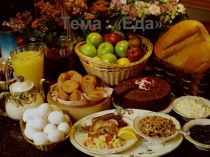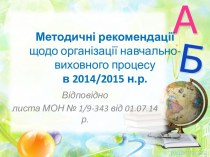- Главная
- Разное
- Бизнес и предпринимательство
- Образование
- Развлечения
- Государство
- Спорт
- Графика
- Культурология
- Еда и кулинария
- Лингвистика
- Религиоведение
- Черчение
- Физкультура
- ИЗО
- Психология
- Социология
- Английский язык
- Астрономия
- Алгебра
- Биология
- География
- Геометрия
- Детские презентации
- Информатика
- История
- Литература
- Маркетинг
- Математика
- Медицина
- Менеджмент
- Музыка
- МХК
- Немецкий язык
- ОБЖ
- Обществознание
- Окружающий мир
- Педагогика
- Русский язык
- Технология
- Физика
- Философия
- Химия
- Шаблоны, картинки для презентаций
- Экология
- Экономика
- Юриспруденция
Что такое findslide.org?
FindSlide.org - это сайт презентаций, докладов, шаблонов в формате PowerPoint.
Обратная связь
Email: Нажмите что бы посмотреть
Презентация на тему по теме: Russian dialects
Содержание
- 2. Classification1. Northern Russiana. Pomor (Arkhangelsk and Murmansk)b. Ladoga-Tikhvinc. Transitional groups: Onega, Lacha, Belozersk-Bezhetskd. Vologdae. Kostroma-Yaroslavl
- 3. 2. Central Russian a. Western i. Groups with okanye
- 4. 3. Southern Russian a. Western (Bryansk, Smolensk, southern parts
- 6. Kursk and Oryol dialect
- 7. Phonetic: • akanye (the vowel «а» is
- 8. Morphology And Grammar: • soft final /tʲ/ in
- 9. Vocabulary: Дежа, дежка – посуда для приготовления
- 12. The status of language:
- 13. 1. Kerek is an extinct language of Russia
- 14. 2. Kamassian is an extinct Samoyedic language, included
- 15. 3. Akkala Sami is a Sami language that
- 16. 4. The Even language /eɪˈvɛn/, also known as
- 17. Скачать презентацию
- 18. Похожие презентации
Classification1. Northern Russiana. Pomor (Arkhangelsk and Murmansk)b. Ladoga-Tikhvinc. Transitional groups: Onega, Lacha, Belozersk-Bezhetskd. Vologdae. Kostroma-Yaroslavl


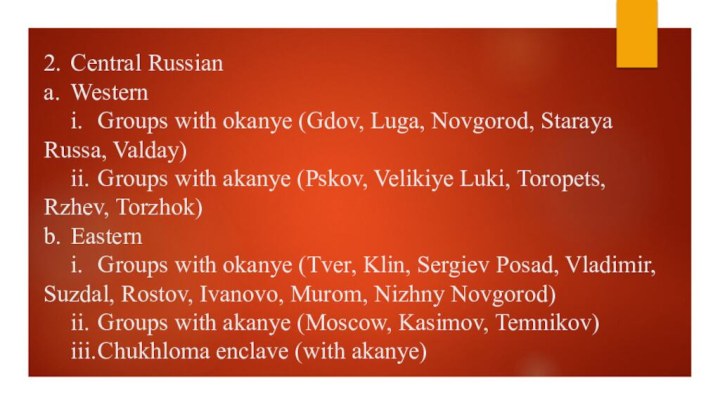



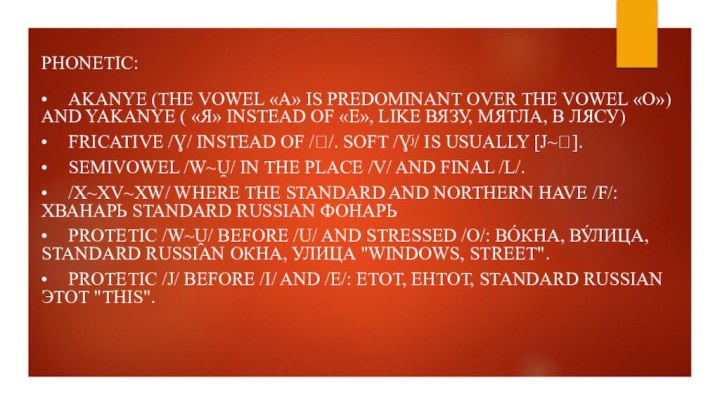


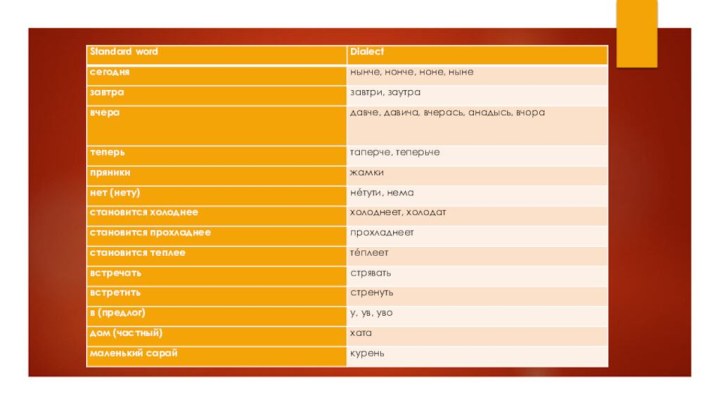







Слайд 2
Classification
1. Northern Russian
a. Pomor (Arkhangelsk and Murmansk)
b. Ladoga-Tikhvin
c. Transitional groups: Onega, Lacha,
Belozersk-Bezhetsk
Слайд 3 2. Central Russian a. Western i. Groups with okanye (Gdov, Luga, Novgorod, Staraya
Russa, Valday) ii. Groups with akanye (Pskov, Velikiye Luki, Toropets, Rzhev,
Torzhok) b. Eastern i. Groups with okanye (Tver, Klin, Sergiev Posad, Vladimir, Suzdal, Rostov, Ivanovo, Murom, Nizhny Novgorod) ii. Groups with akanye (Moscow, Kasimov, Temnikov) iii. Chukhloma enclave (with akanye)Слайд 4 3. Southern Russian a. Western (Bryansk, Smolensk, southern parts of Pskov
and Tver) b. Transitional group A (Mosalsk, Kozelsk, Zhizdra, Karachev, Sevsk,
Rylsk) c. Central (Belgorod, Kursk, Oryol) d. Transitional group B (Serpukhov, Kolomna, Kaluga, Tula, Elets, Stary Oskol) e. Eastern (Lipetsk, Tambov, Ryazan, Voronezh).Слайд 7 Phonetic: • akanye (the vowel «а» is predominant over the
vowel «о») and yakanye ( «я» instead of «е»,
like вязу, мятла, в лясу)• Fricative /ɣ/ instead of /ɡ/. Soft /ɣʲ/ is usually [j~ʝ].
• Semivowel /w~u̯/ in the place /v/ and final /l/.
• /x~xv~xw/ where the Standard and Northern have /f/: хванарь Standard Russian фонарь
• Protetic /w~u̯/ before /u/ and stressed /o/: во́кна, ву́лица, Standard Russian окна, улица "windows, street".
• Protetic /j/ before /i/ and /e/: етот, ентот, Standard Russian этот "this".
Слайд 8 Morphology And Grammar: • soft final /tʲ/ in 3rd person
forms of verbs: он ходить, они ходять "he goes,
they go"• Occasional dropping of the 3rd person ending /tʲ/ at all: он ходи, они ходя "he goes, they go"
• Oblique case forms of personal pronouns мяне́, табе́, сабе́ instead of Standard Russian мне, тебе, себе "me, you, -self".
• Presence the vowel «ы» in nouns of neuter gender – пятны, окны.
• The flexions of I and II conjugation are the same: пишуть, колють, дышуть, носють
• Short forms of infinitives: несть, плесть, весть НО! Итить
